

Xinjiang's progress was made possible by the peaceful liberation of the region, the 70th anniversary of which will be celebrated Wednesday.
The region has seen improved living standards for its people and as proof of the general stability and sound development momentum, not a single terrorist attack has occurred in Xinjiang over the past three years.
URUMQI, Sept. 24 -- The city of Shihezi is a sprawling green area home to 670,000 people. As September ends and the harvest season arrives, farmers are ready to reap the large cotton fields in the city's suburbs.
Shihezi, about 150 km northwest of Urumqi, is a young city established in the 1950s in Xinjiang Uygur Autonomous Region. It is one of the nine bustling cities that has risen from the bleak Gobi Desert.
While about 1,600 km away in the southwest, Kashgar, an ancient Silk Road city, maintains the charm and authenticity of a 2,000-year-old town.
The contrasting landscape marks the vastness of Xinjiang, which covers about one-sixth of China's land territory, and epitomizes how Xinjiang has progressed both economically and culturally.
This progress was made possible by the peaceful liberation of the region, the 70th anniversary of which will be celebrated Wednesday. In 1949, the liberation struggle gained momentum across the country and the revolutionary struggle of the people of all ethnic groups surged forward in Xinjiang, Tao Zhiyue, garrison commander of Xinjiang, and Burhan, chairman of the Xinjiang Provincial Government, renounced their allegiance to the Kuomintang and welcomed in the First Army Group of the First Field Army of the Chinese People's Liberation Army (PLA), led by General Wang Zhen.
From then on, Xinjiang embarked upon a journey of increasing prosperity, unity and stability.
As proof of the general stability and sound development momentum, not a single terrorist attack has occurred in Xinjiang over the past three years.
Children pose for a photo at a kindergarten at Liangzhongchang Village in Yutian County of Hotan, northwest China's Xinjiang Uygur Autonomous Region, Feb. 13, 2019. (Xinhua/Zhao Ge)
SOCIAL DEVELOPMENT
In the years that immediately followed the peaceful liberation, Xinjiang's average life expectancy was 30 years. The figure reached 72.35 years in 2018. Now 25 million people live in 14 prefectures and cities in the region.
Before the liberation, most arable land in Xinjiang was seized by a handful of landlords, leaving very little to the majority of farmers. Serfdom existed in southern Xinjiang, where overlords owned their serfs from head to toe.
Samsak, a herder in Kashgar, owned nothing more than the clothes he was wearing when PLA soldiers liberated him. His name, meaning "garlic" in Uygur language, was given by his master. From the age of 17 to the age of 60, he had done nothing but herded sheep, yet he owned none of them.
Through a democratic reform that toppled the old system, ordinary people like Samsak received their own land and sheep and became masters of their own fate.
In 1955, the system of regional ethnic autonomy was implemented in Xinjiang, offering a further guarantee to the people of Xinjiang in exercising their right as masters of the country.
In 1950, Xinjiang only had 3,000 ethnic minority cadres. By 2018, the ethnic cadres made up 50.3 percent of the total in Xinjiang to reach 428,000, of whom over half are women.
Xinjiang has seen improved living standards for its people over the past seven decades. Public services, such as free health checkups for all, critical illness insurance, free preschool education for rural children, and housing projects for herders and farmers, have increased people's sense of fulfillment. Tap water, stable power supply and roads have been made accessible to herders who live in the most remote border areas.
During an inspection tour to Xinjiang in 2014, President Xi Jinping called for steadfast efforts to attain leapfrog development, while stressing efforts must be made to improve people's livelihoods and win the support of the people.
Living on the edge of Taklimakan Desert in Hotan, Tursuntoht Jume, 61, cherishes the tap water supply that was only recently installed in his home. "For half of my life, I had been drinking from the pond. Drinking directly from the tap, this makes me happier than anything else," he said.
Safe drinking water, among other things, is one criterion to gauge poverty relief efforts in Xinjiang. From 2014 to 2018, Xinjiang lifted over 2.3 million people above the poverty line, defined by a per capita annual income of 2,300 yuan (around 333 U.S. dollars) at 2010 prices. The poverty rate in the region is 6 percent. By next year, these remaining people are expected to be taken off the impoverished list.
 |

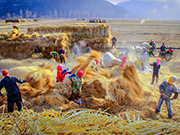 Award-winning photos show poverty reduction achievements in NE China's Jilin province
Award-winning photos show poverty reduction achievements in NE China's Jilin province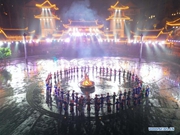 People dance to greet advent of New Year in Ameiqituo Town, Guizhou
People dance to greet advent of New Year in Ameiqituo Town, Guizhou Fire brigade in Shanghai holds group wedding
Fire brigade in Shanghai holds group wedding Tourists enjoy ice sculptures in Datan Town, north China
Tourists enjoy ice sculptures in Datan Town, north China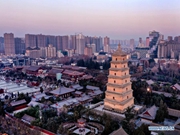 Sunset scenery of Dayan Pagoda in Xi'an
Sunset scenery of Dayan Pagoda in Xi'an Tourists have fun at scenic spot in Nanlong Town, NW China
Tourists have fun at scenic spot in Nanlong Town, NW China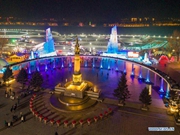 Harbin attracts tourists by making best use of ice in winter
Harbin attracts tourists by making best use of ice in winter In pics: FIS Alpine Ski Women's World Cup Slalom
In pics: FIS Alpine Ski Women's World Cup Slalom Black-necked cranes rest at reservoir in Lhunzhub County, Lhasa
Black-necked cranes rest at reservoir in Lhunzhub County, Lhasa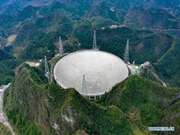 China's FAST telescope will be available to foreign scientists in April
China's FAST telescope will be available to foreign scientists in April